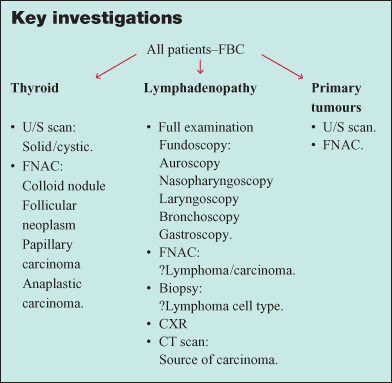Definition
A neck lump is any congenital or acquired mass arising in the anterior or posterior triangles of the neck between the clavicles inferiorly and the mandible and base of the skull superiorly.
Key Points
- Thyroid swellings move upwards (with the trachea) on swallowing.
- Most abnormalities of the neck are visible as swellings.
- Ventral lumps attached to the hyoid bone, such as thyroglossal cysts, move upwards with both swallowing and protrusion of the tongue.
- Multiple lumps are almost always lymph nodes.
- In all cases of lymphadenopathy a full head and neck examination, including the oral cavity is mandatory.
Differential Diagnosis
- 50% of neck lumps are thyroid in origin.
- 40% of neck lumps are caused by malignancy (80% metastatic usually from primary lesion above the clavicle; 20% primary neoplasms: lymphomas, salivary gland tumours).
- 10% of neck lumps are inflammatory or congenital in origin.
Thyroid
- Goitre, cyst, neoplasm.
Neoplasm
- Metastatic carcinoma.
- Primary lymphoma.
- Salivary gland tumour.
- Sternocleidomastoid tumour.
- Carotid body tumour (rare).
Inflammatory
- Acute infective adenopathy.
- Collar stud abscess.
- Parotitis.
Congenital
- Thyroglossal duct cyst.
- Dermoid cyst.
- Torticollis.
- Branchial cyst.
- Cystic hygroma.
Vascular
- Subclavian or brachiocephalic ectasia (common).
- Subclavian aneurysm (rare).
Important Diagnostic Features
Children
- Congenital and inflammatory lesions are common.
- Cystic hygroma: in infants, base of the neck, brilliant transillumination, ‘come and go’.
- Thyroglossal or dermoid cyst: midline, discrete, elevates with tongue protrusion.
- Torticollis: rock hard mass, more prominent with head flexed, associated with fixed rotation (a fibrous mass in the sternocleidomastoid muscle).
- Branchial cyst (also fistulae or sinus): anterior to the upper third of the sternocleidomastoid.
- Viral/bacterial adenitis: usually affects jugular nodes, multiple, tender masses.
- Neoplasms are unusual in children (lymphoma most common).
Young Adults
Inflammatory neck masses and thyroid malignancy are common.
- Viral (e.g. infectious mononucleosis) or bacterial (tonsillitis/pharyngitis) adenitis.
- Papillary thyroid cancer: isolated, non-tender, thyroid mass, possible lymphadenopathy.
Over-40s
Neck lumps are malignant until proven otherwise.
- Metastatic lymphadenopathy: multiple, rock hard, non-tender, tendency to be fixed.
- 75% in primary head and neck (thyroid, nasopharynx, tonsils, larynx, pharynx), 25% from infraclavicular primary (stomach, pancreas, lung).
- Primary lymphadenopathy (thyroid, lymphoma): fleshy, matted, rubbery, large size.
- Primary neoplasm (thyroid, salivary tumour): firm, non-tender, fixed to tissue of origin.

Stay updated, free articles. Join our Telegram channel

Full access? Get Clinical Tree


